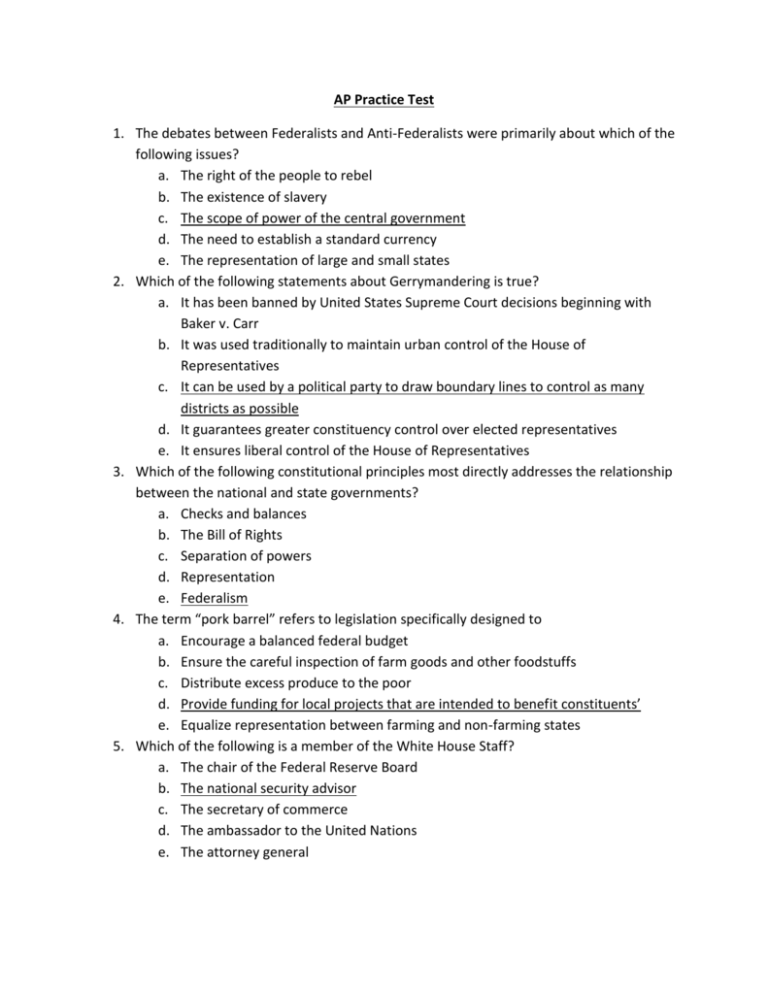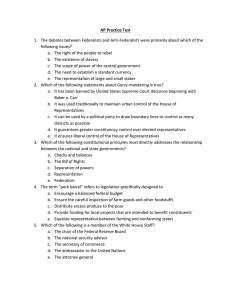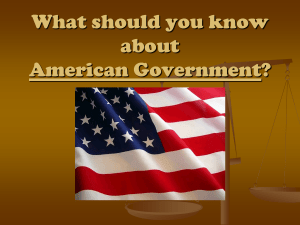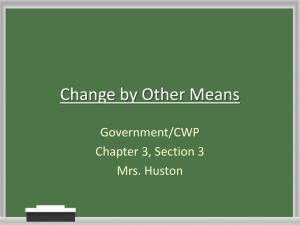AP Practice Test The debates between Federalists and Anti
advertisement

AP Practice Test 1. The debates between Federalists and Anti-Federalists were primarily about which of the following issues? a. The right of the people to rebel b. The existence of slavery c. The scope of power of the central government d. The need to establish a standard currency e. The representation of large and small states 2. Which of the following statements about Gerrymandering is true? a. It has been banned by United States Supreme Court decisions beginning with Baker v. Carr b. It was used traditionally to maintain urban control of the House of Representatives c. It can be used by a political party to draw boundary lines to control as many districts as possible d. It guarantees greater constituency control over elected representatives e. It ensures liberal control of the House of Representatives 3. Which of the following constitutional principles most directly addresses the relationship between the national and state governments? a. Checks and balances b. The Bill of Rights c. Separation of powers d. Representation e. Federalism 4. The term “pork barrel” refers to legislation specifically designed to a. Encourage a balanced federal budget b. Ensure the careful inspection of farm goods and other foodstuffs c. Distribute excess produce to the poor d. Provide funding for local projects that are intended to benefit constituents’ e. Equalize representation between farming and non-farming states 5. Which of the following is a member of the White House Staff? a. The chair of the Federal Reserve Board b. The national security advisor c. The secretary of commerce d. The ambassador to the United Nations e. The attorney general 6. In 1987 the cooperation among the National Association for the Advancement of Colored People (NAACP), the National Organization for Women (NOW), and the American Civil Liberties nomination to the United States Supreme Court was an example of a. Impeachment b. Litigation c. Coalition building d. The recall process e. The initiative process 7. The Supreme Court’s power of judicial review permits the Court to overrule all of the following EXCEPT a. Lower-court decisions b. State legislation c. Acts of Congress d. The Bill of Rights e. Executive orders 8. Which of the following statements about political parties and the United States Constitution is true? a. According to the Constitution only two major political parties may exist at any time b. The Constitution requires political parties to be restricted by both federal and state law. c. The Constitution indicates that political party leaders at the national level be elected by political party leaders at the state level d. The Constitution specifies that political party leaders must be native-born United States citizens e. The issue of political parties is not addressed in the Constitution. 9. The free-exercise clause protects a. The president from forcibly revealing private conversations with staff b. Individuals who, for religious reasons, refuse to pay Social Security taxes c. Voluntary prayer by student groups before school d. A person’s right to burn the American flag e. A person’s right to practice polygamy 10. Which of the following United States Supreme Court cases established the principle of judicial review? a. McCulloch v. Maryland b. Gibbons v. Ogden c. Wolf v. Colorado d. Roe v. Wade e. Marbury v. Madison 11. Which of the following is the most likely consequence of divided government? a. Reorganization of the federal bureaucracy b. Conflicts between states c. Delays in confirmation of federal court nominees d. Conflicts between national government and states e. Elimination of the seniority rule in congress 12. In Plessy v. Ferguson, the United States Supreme Court ruled that state-imposed racial segregation is constitutional, based on the a. “clear and present danger” doctrine b. “separate but equal” doctrine c. Dangerous tendency” doctrine d. Privileges and immunities clause e. Necessary and proper clause 13. Which of the following is a fundamental element of the United States Constitution? a. Recognition of the centrality of political parties in government b. Direct election of members of the executive branch c. An executive branch that is more powerful than the legislature d. Emphasis on a unitary system of government e. Division of government authority across political institutions 14. Which of the following best explains the principle of stare decisis? a. It requires that at least four Supreme Court justices agree to hear a case b. It encourages presidents to take judicial experience into account when nominating judges c. It encourages judges to follow precedent when deciding cases d. It reinforces the philosophy of judicial activism e. It increases the number of cases judges are required to hear 15. Which of the following is NOT a way in which the federal government regulates campaigns? a. By requirements for disclosure of campaign donations b. By establishment of federal agencies to regulate campaign finance activities c. By limits on the distribution of soft money d. By limits on individual donations to campaigns e. By prohibitions on negative advertising 16. Which of the following statements about the Senate is true? a. Each state is represented in the Senate according to its population b. The Senate, unlike the House, has a Rule Committee c. Individual senators can exercise substantial influence over the legislative process d. The Senate has a strict time limit on debates e. The Senate is more responsible that the House for initiating appropriations legislation 17. The framers of the United States Constitution left decisions on voting eligibility to the a. Civil rights agencies b. Individual states c. United States Supreme Court d. House of Representatives e. Senate 18. In the process and structure of public policy-making, “iron triangles” refer to the a. Bargaining and negotiating process between the President and Congress about the direction of domestic policy b. Dominance of corporate power in setting the national policy agenda for economic expansion c. Interrelationship among federal, state and local levels of government in the policy process d. Networks of congressional committees, bureaucratic agencies, and interest groups that strongly influence the policy process e. Group of presidential advisers who formulate the President’s foreign policy agenda 19. One reason for the persistence of a two-party system in the United States is a. The lack of divisive issues in United States politics b. The separation of powers c. The single-member district electoral system d. The lack of a strong labor movement e. Low voter turnout in most elections 20. Both Gitlow v. New York and New York Times v. Sullivan are United States Supreme court cases that dealt with which of the following amendments to the United States Constitution? a. First Amendment b. Second Amendment c. Fourth Amendment d. Fifth amendment e. Fifteenth amendment 21. Which of the following is true of political action committees (PACs) a. They are a part of political party organizations b. They make campaign contributions to gain access to legislators c. They are allowed to contribute to only one candidate in a given contest d. They effectively control the presidential campaigns e. They may operate at the state level but not at the national level 22. All of the following are ways that the legislative branch can check the powers of the executive branch EXCEPT: a. Congress may remove the president through it impeachment and conviction powers b. Congress may override a presidential veto c. Congress may pass a law declaring a presidential action unconstitutional d. The Senate may refuse to approve a presidential appointment e. The Senate may refuse to approve a treaty negotiated by the president 23. Which of the following best describes the primary formal role of the attorney general? a. Providing legal advice for the president and cabinet secretaries b. Serving as a liaison between the president and the Supreme Court c. Serving as the chief executive officer of the Department of Justice d. Directing the Government Accountability Office (GAO) e. Persuading the Senate to confirm the president’s judicial nominees 24. Which of the following is an example of congressional oversight” a. Holding hearings for review of an executive agency’s activities b. Assisting constituents with particular problems c. Reporting campaign contributions to the Federal Election Commission d. Signing trade agreements with other countries without input from the president e. Conducting ethics investigations of congressional leadership 25. How is a president chosen when none of the candidates receives a majority of the electoral college vote? a. There is a national runoff election between the two candidates with the greatest number of electoral votes b. The United States Supreme Court directly elects the president c. The election is ruled null and void and Congress appoints a new president d. The Senate chooses a new president by a majority vote of its entire membership e. The House chooses a new president by a majority vote of its state delegations 26. The Americans with Disabilities Act, which provides protections for the disabled, is an example of a. State supremacy b. Horizontal federalism c. Affirmative action d. Dual federalism e. A federal mandate 27. Which of the following best describes the difference between an open and closed primary? a. Voters must pay a poll tax to vote in a closed primary, but not in an open primary b. Voters are allowed to split their ticket in a closed primary but not in an open primary c. Only voters who register as members of a political party may vote inthat party’s closed primary, while independents and others may be eligible ot vote in open primaries d. Open primaries require a run-off system, while closed primaries do not e. Candidates must seek the approval of the party organization to run in a closed primary, but anyone may be a candidate in an open primary 28. Which of the following best describes the concept of political efficacy? a. It is the belief that the average citizen can make little or no difference in an election b. It is the belief that an intelligent voting decision cannot be made without information c. It is the belief that the media must provide unbiased information for citizens to be able to make well-informed choices. d. It is the belief that one can make a difference in politics by expressing an opinion and acting politically e. It is the belief that politicians must keep the electorate well-informed if they are to govern efficiently 29. Which of the following is an example of presidential use of inherent powers a. George H.W. Bush’s appointment of Clarence Thomas b. Bill Clinton’s line-item veto of some congressionally authorized funds to the states c. Thomas Jefferson’s Louisiana Purchase d. Woodrow Wilson’s signing of the Treaty of Versailles e. Dwight Eisenhower’s deployment of troops to Arkansas 30. Which of the following statements about writs of certiorari is accurate? a. Cases appealed by the solicitor general are automatically granted certiorari b. The Supreme Court grants certiorari for less than 5% of the cases appealed to it c. The Supreme Court has historically granted certiorari to all separation of powers cases d. The Supreme Court does not grant certiorari to cases involving state laws e. Federal district courts sometimes issue writs of certiorari to state appellate courts











